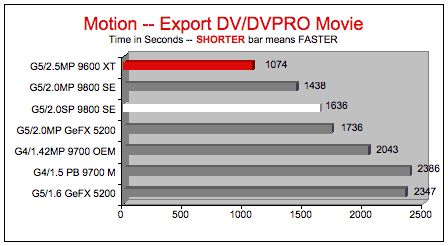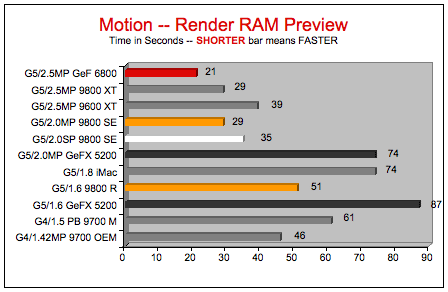
|
|
Originally posted August 25th, 2004, by rob-ART
morgan, mad scientist There's a lot of excitement about the potential of Apple's new Motion as a weapon in the arsenal of the Digital Video Artist. Most of the email we've been receiving is in regard to "What hardware do I need to get optimal performance from Motion?" We're still feeling our way around on this new software. While we continue to plum the depths of Motion, we'll start by posting some sample results from two benchmarks created by Adam Filipowicz. TEST 1: EXPORT DV/DVCPRO - NTSC MOVIE TEST 2: RAM PREVIEW RENDER GRAPH LEGEND SUMMARY WHAT WE'VE LEARNED SO FAR ABOUT MOTION OPTIMIZATION GRAPHICS CARD SPEED AND VRAM COUNTS We opened and rendered "Water - Open" template. Then we opened and rendered "Brush Strokes - Open" template. The VRAM used was now up to 171MB! It's no wonder Apple recommends a video card with at least 128MB of VRAM. There's more. Notice the ORANGE and BLACK bars in the RAM PREVIEW graph. We tested a "Rev B" G5/2.0GHz MP Power Mac that comes standard with the GeForceFX 5200 (64MB VRAM). It took 74 seconds to do the RAM PREVIEW render. The same model of Power Mac with a 9800 Pro SE (256MB) took only 29 seconds. Think of it. Just by upgrading the graphics card, we gained 155% in RAM PREVIEW render speed! A similar advantage is achieved by upgrading the G5/1.6GHz MP Power Mac from a GeForceFX 5200 to a Radeon 9800 Pro Retail edition graphics card. THE MORE MEMORY, THE MERRIER We used System Manager (as well as Activity Monitor) to observe memory useage. With nothing but those two apps running on a G5 Power Mac with 8096MB total (8GB), we launched Motion and began to render a RAM PREVIEW of "Fire - Mortise 2" template. Motion was now using 1GB for itself. We continued. We opened and rendered "Water - Open" template. Then we opened and rendered "Brush Strokes - Open" template. Now Motion was using 2.7GB for itself. We're told that Motion will "eat" up to 4GB, if you have it to spare, though we never got that far. If that's true, you G5 owners might want to go up to 6GB or 8GB -- especially if you are running Photoshop and Final Cut Pro at the same time you are using Motion. With Motion still running, we launched Photoshop CS (memory cache set to max). We opened a 421MB document and rotated it 30 degrees. We now only had 1.8GB left out of a total of 8GB. Pause and think on that! When we tried to load a fourth template in Motion. It crashed. I know that OS X has virtual memory, but do you really want your drive thrashing to to keep up with all of this? DUAL PROCESSOR COUNTS SOME Note in the graphs above that the WHITE bar is the results of that experiment. RAM PREVIEW gained only 21% and the EXPORT gained only 14% from the presence of a second CPU. To express it another way, a single G5/2.0 should be 25% faster than at G5/1.6, if you just take into account clock speed. But in reality, the single G5/2.0 was 149% faster rendering the RAM PREVIEW and 43% faster rendering the EXPORT movie. That means that other factors must be coming to play including memory speed, bus speed, memory capacity, graphics card speed, VRAM capacity etc. "EVERYTHING IS FAST OR NOTHING IS FAST" Which brings us back to our initial conclusion: If you want maxiumum performance with minimum waiting, get a "kick butt" dual G5 with the best graphics card you can afford. RELATED ARTICLES Radeon 9800 XT versus Radeon 9800 SE vs Radeon 9600 XT Motion Review by IT Inquirer G5/2.5GHz MP Power Mac versus others. Final Cut Pro test of different Macs. SOURCES OF TEST PRODUCTS These are the Apple Macintoshes featured in the graphs above: An Aluminum G4/1.5GHz PowerBook with 1.25GB of memory and 128MB version of Radeon 9700 Mobility, and 5400rpm 80GB system drive. A G5/1.6GHz Power Mac with 1.25GB of memory and a GeForceFX 5200 graphics card (8X, 64MB VRAM) and a Radeon 9800 Pro Retail graphics card (2X/4X, 128MB VRAM) A G4/1.42GHz MP Power Mac with 2GB of memory and a Radeon 9700 Pro graphics card (4X, 128MB VRAM) A G5/2.0GHz MP Power Mac "Rev B" with 4.5GB of memory and a GeForceFX 5200 graphics card (8X, 64MB VRAM) A G5/2.0GHz MP Power Mac "Rev A" with 4GB of memory and a Radeon 9800 Pro Special Mac Edition graphics card (8X, 256MB VRAM) A G5/2.5GHz MP Power Mac with 1GB of memory and a Radeon 9600 XT graphics card (8X, 128MB VRAM) as well as a Radeon 9800 XT graphics card (8X, 256MB VRAM). All systems were running Mac OS X 10.3.5 (required for Motion) SOURCES OF CPU AND MEMORY UPGRADES MacGurus (CPU upgrades, memory upgrades) Other World Computing (CPU upgrades, memory upgrades) PowerMax (New and refurbished systems) Small Dog Electronics (New and refurbished systems, CPU upgrades) TransIntl (memory upgrades) SOURCES OF GRAPHICS CARD UPGRADES If you already own a G5 Power Mac and want to upgrade to the 9600 XT or 9800 XT, you can't. They aren't available as kits from Apple (yet). And they aren't in retail channels (yet). Apple's Online Store does, however, sell aftermarket kits for the Radeon 9800 Pro "Mac Special Edition" ($399), GeForce 6800 GT ($499), and the GeForce 6800 Ultra DDL ($599). There are various resellers carrying 8X (G5 only) Radeon 9800 Pro Mac Special Edition. Buy.com has it at a good price ($309 after subtracting the $10 off coupon) plus free shipping. Check also with Other World Computing and Small Dog Electronics. If you own a G4 Power Mac with a 2X or 4X AGP slot, your best option is the Radeon 9800 Pro Mac Edition (128MB). The lowest price I've seen is $264 at Buy.com (after subtracting the $10 off coupon) with free shipping. Check also with Other World Computing or Small Dog Electronics or the Apple Online Store. Has Bare Feats helped you? How about helping Bare Feats?
Updated on October 13th with Radeon 9800 XT numbers on the G5/2.5
and updated experiments with VRAM and main memory usage.
The export function is a CPU crunch test using a project created by Adam Filipowicz. He limited it to 100 frames so it would take "forever" to render on slower machines.
This graph shows the results of how long it takes to render a RAM PREVIEW of the "Fire - Mortise 2" template. Since this uses a Pyro particle effect -- which uses pixel shading -- it appears to hand off some of the rendering to the graphics card. This was especially apparent when you put a different graphics card in the same Power Mac. (The ORANGE and BLACK bars highlight this.) 
Graphics Cards
GeF 6800 = nVidia GeForce 6800 Ultra DDl (256MB)
9800 XT = Radeon 9800 XT OEM (256MB)
9600 XT = Radeon 9600 XT OEM (128MB)
9800 SE = Radeon 9800 Pro Special Mac Edition (256MB)
9800 R = Radeon 9800 Pro Retail (128MB)
9700 OEM = Radeon 9700 Pro OEM (128MB)
9700 M = Radeon 9700 Mobility (128MB)
GeFX 5200 = nVidia GeForceFX 5200 (64MB)
CPUs
G5/2.5MP = G5/2.5GHz MP Power Mac
G5/2.0MP = G5/2.0GHz MP Power Mac
G5/2.0SP* = G5/2.0GHz MP Power Mac (*C.H.U.D. tools diabled one CPU)
G5/1.8 iMac = G5/1.8GHz iMac with GeForceFX 5200 GPU
G5/1.6 = G5/1.6GHz Power Mac
G4/1.5 PB = G4/1.5GHz PowerBook (15" Aluminum)
G4/1.42MP = G4/1.42GHz MP Power Mac
To make Motion move, you need the best of everything. Start with a fast Dual G5 with 4GB of RAM -- 8GB would be even better. Add fast graphics card -- Radeon 9800 Pro SE or XT or GeForce 6800 Ultra -- the more VRAM the better.
We used the ATI and NVIDIA Tool to monitor VRAM usage on the G5/2.0 MP. Before we launched Motion, only 7MB of VRAM had been used up. We launched Motion, opened and rendered a RAM PREVIEW the "Fire - Mortise 2" template. Now it showed 53MB VRAM used.
We learned that Motion is memory hungry and dynamically grabs up to 80% of available RAM (unless you change the preferences).
Using System Manager app, we observed that EXPORT only exercises one CPU while RAM PREVIEW exercises both CPUs in a dual CPU Power Mac. That gave us an idea. We decided to disable the second CPU on the G5/2.0MP using the C.H.U.D. tools.
It could be argued that performance analysis cannot and should not be compartmentalized. When performance tuning, the idea is to avoid bottlenecks in any subsystem. The faster the disk, the faster source footage can be read into RAM. The more RAM, the more source footage can be cached. The faster the system bus, the faster the source footage can be fed from RAM to the GPU. The more shader units and higher clock speed on the GPU, the more filter/blend mode operations can be processed at once. The more VRAM, the more rendered footage can be off-loaded from RAM.
To run Motion, you need at least an 867MHz G4. It will use up to 4GB of memory so you'll want to max that out as well:
The Apple Online Store offers the 9600 XT ($50), 9800 XT ($300-$350), GeForce 6800 GT ($350-$400), and GeForce 6800 Ultra ($450-500) as "configure-to-order" (CTO) options when purchasing a new G5 Power Mac.
"BARE facts on Macintosh speed FEATS"
Email , the webmaster and mad scientist

